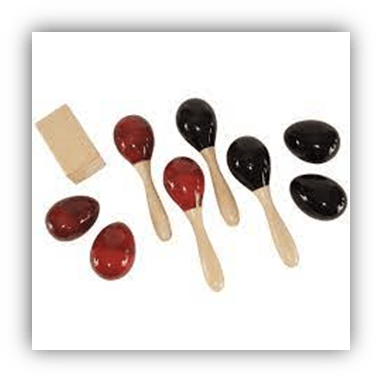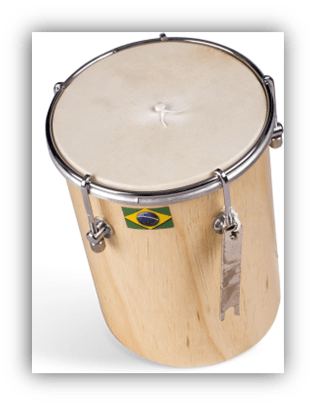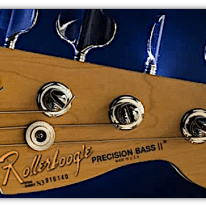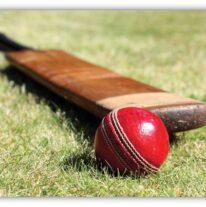Recently, our esteemed colleague rollerboogie contributed the excellent “Field Guide to Hand Percussion:”
It’s a superb introduction to the basic percussion instruments that a listener is likely to encounter.
It made the heart of this long-time percussionist all warm and fuzzy.
But the field of hand percussion instruments is wider than many people are aware of.
So I would like to spotlight some of the more exotic instruments! They’re perhaps less familiar, but their sounds may be even more distinctive.

One of my favorites is the SHEKERE (pronounced “SHAY-kuh-reh”).
This is a variety of shaker that originated in West Africa, and it has a design twist.

With a typical shaker, the loose material which provides the impact – the actual percussion – is on the inside of the shaker and essentially hidden from view.
But with a Shekere, this is reversed.
Generally a gourd is used, and the beads, seeds, or shells are woven around the outside, instead of being contained inside the gourd. These can be very colorful and eye-catching, depending on how the various colors of the beads are arranged.
Shekeres can also be quite LOUD. I think having the beads on the outside of the gourd lets the sound travel farther and more freely. I’ve got extensive experience with a large, powerful Shekere, and believe me: a jumbo Shekere – especially one with seeds woven on the outside – can be downright dangerous if not handled carefully.
But if you’re looking for a percussion instrument that can hold its own in a band setting, the Shekere is your money shaker.

Closely related is the CABASA, or AFUCHE (pronounce “ah-FOO-cheh”).
This can be thought of as a Latin American update on the Shekere, with a more industrial flavor. Lengths of ball bearing chain are loosely wrapped around a metal-lined cylinder, and a handle is attached. The ball bearing chains moving along the ridged metal cylinder create the sound.

If you suspect that the use of so much metal gives the Afuche a brighter, harsher sound that can cut through most mixes of instruments – you’re exactly right.
But used lightly, it can enhance instead of overpower. And the design gives the player access to a varied palette of sounds, from gentle shaker-type grooves to more complex and abrupt rhythms.
Examples:
- Your Ways – Jackson 5
- Desafinado – Stan Getz and Charlie Byrd
Next is one of my very favorite percussion instruments: The CUICA:

(…pronounced “koo-EE-kuh”)!
The Cuica stands alone in the world of percussion due to its entirely novel – and nearly ludicrous – design. The Cuica is a friction drum. It’s not struck or shaken or turned. Instead, it’s rubbed.
Imagine that you have a very small, simple drum – basically, a short tube covered at one end by a membrane or skin that functions as the drum head.

To the center of the head, attach a thin, wooden dowel. Et voilà: Cuica!
Usually, the player uses a small, damp cloth to rub the wooden dowel – that creates the friction. The sound is created by that vibration being transmitted through the drum head.

At the same time, the musician can press on the drum head to vary the pitch.
What results is one of the most organic, animalistic sounds imaginable. There’s probably no better way to emulate the sound of an animal in pain, or in heat. It’s not for the easily embarrassed.
Based on that description, you may be surprised to learn that the Cuica is featured in a number of well-known songs.
But surprise is one of the Cuica’s specialties!
Examples:
- Bird of Beauty – Stevie Wonder
- Me and Julio Down By the Schoolyard – Paul Simon
- Could You Be Loved – Bob Marley & the Wailers
- Soul Bossa Nova – Quincy Jones
The BERIMBAU (pronounced “BEHR-im-BOW”) takes us from the ridiculous to the bizarre:
OK. So, what we have here is a type of musical bow. The bow is attached to an open gourd, and the string – typically a metal wire – is struck with a small stick. Often, a small woven shaker is held in the same hand that holds the stick, and this adds a layer to the sound.

The body of the instrument is held in the other hand, along with a coin or small stone which is pressed against the string, effectively turning the bowstring into TWO DIFFERENT LENGTHS OF PLAYABLE STRING.
The lengths of the two theoretical strings are entirely fluid – it depends entirely upon where the player pushes the stone against the string. It’s wild.

This instrument also is thought to have originated in Africa, and eventually became associated with the Brazilian martial art Capoeira by way of the slave trade.
The sound is as easy to recognize as it is difficult to grasp. You can hear it featured gloriously at the beginning of this foundation-shaker:
- St. Teresa – Joan Osborne
In a survey such as this, it’s only appropriate to end with the sublime:
The ASALATO (pronounced “AH-suh-LAH-to”) is probably the instrument on this list that’s least familiar. Indeed, it’s an instrument that only recently has settled into my consciousness. In contrast, I’ve been familiar with these other instruments for multiple decades.

I think of the Asalato as sublime because of several reasons. Firstly, the design of the instrument is… not quite simple, but it has an elegance to it.
Secondly, Asalato are smaller and more portable than anything else on this list:
I think it’s safe to say that the Asalato, in it original form, was a pair of dried seedpods, with the seeds still inside, attached by whatever natural fibers were nearby and available. It seems to be that a lot of percussion instruments had their origin in Africa; I think that’s likely also true for the Asalato.

Imagine being the very first person to figure out how to attach two seedpods at just the right length, so that you could not only shake them but also – at the same time! – flip the shakers around your hand like that, holding one end and catching the loose end with the same hand.
I bet that person was legendary. And then, someone figured out that they could hold TWO pairs of Asalato at the same time, one in each hand, and play them together! IN DIFFERENT, SIMULTANEOUS RHYTHMS, even.
I’ll bet that person was a hero throughout the land!
Thanks again to rollerboogie for bringing up the topic of percussion!
Between his article and this one, we’ve touched on most, but not nearly all, of the standard percussion instruments.
Not only is the field wide, it’s also deeper than most understand. I’m resisting the temptation to hare off into the Mystic in this article.

But if you’d like to learn some about the metaphysical underpinnings of rhythm and percussion, I highly recommend Mickey Hart’s 1990 book Drumming at the Edge of Magic: A Journey into the Spirit of Percussion.
The venerable Grateful Dead drummer lays it out with all the skill of a well-seasoned pro.
Let the author know that you liked their article with a “Green Thumb” Upvote!




I’ve never heard of the berimbau or asalato, but they’re fascinating. Have you played either?
My son is visiting for the holiday. After I finished listening to the berimbau video, he came upstairs to my office and asked, “Were you just whisking eggs up here?”
I guess it sounded a little different from downstairs.
Whisking eggs, omg that’s hilarious. But I guess in terms of common household sounds, that’s as close a comparison as any…
I messed around with a berimbau once years ago but didn’t understand the mechanics of it then. So the short answer is no.
I got a bit obsessed with the asalato earlier this year and tried it out. I haven’t found a pair that really fits my hands yet. The length of the string is a very subtle thing. I’m thinking about taking the one I do have and trying to lengthen the string just enough to make it work better…
But again, the short answer is no.
Fantastic, Both Grouse. So happy you did this! Like virgindog, I was not familiar with the last two. They are both amazing. I was going to include the cuica in my article and didn’t so I am glad you did. It’s such a cool and unique instrument. Here are some other cuica songs I had on my list:
Wanna Be Startin’ Something- Michael Jackson (at 2:23)
One Nation Under a Groove- Funkadelic
Magalenha- Sergio Mendes
Dance Pt 1- The Rolling Stones (at 2:46)
Locked Out of Heaven- Bruno Mars (likely a sample, but a good example of what a cuica sounds like)
I really would love to read more from you on the topic of percussion instruments. Perhaps a segment on various hand drums. Lots to cover there.
Rollerboogie, you have completely made my day! I think this is the very first time someone has asked me like that to write something specific. So the answer is yes!
Excellent! Looking forward to it!
Those asalato videos blew my mind!!! Thanks for sharing BG!
Happy Turkey Day (or Tofurkey Day) to all who celebrate!!!
Hijacking both Pauly’s comment and BG’s terrific article on this US Thanksgiving Day to say hello, and thank you to all for your amazing participation and loyalty to the site.
Chime in if you can, in between courses!
That surely calls for another example or two:
https://www.youtube.com/watch?v=s-RAHFUF3U0
🤯 Thanks for making my turkey hangover morning a lot groovier, BG!!!
https://www.youtube.com/watch?v=jzhJuSKJ9N8
Wow there is definitely an element of performance here that takes it to the next level. It’s like fire dancing but if the fire were also a musical instrument…
It’s worth slowing it down to quarter speed to be able to grasp what’s going on. There’s some intricate and surprising stuff going on – in the first one, there’s at least a couple of different ways he’s using the pair in one hand to clack against the pair in the other hand. And in the second one, the way he’s throwing them up in the air – that’s a spectacular little trick.
Informative and entertaining, thanks Both Grouse.
I recognise the Berimbau, I know I’ve seen it somewhere but I can’t think where. Googled what songs it’s been used in and that hasn’t helped. It’ll remain a mystery.
The Cuica and Asalato are new to me. With my lack of co-ordination the Asalato looks like an injury waiting to happen. Whether to my own eyes or flying off and hitting someone else.
Between the title and the photo of the Asalato in the heading, this article borders on NSFW. Which is fine, since I’m off until Monday. 😎
Great stuff, and Happy Thanksgiving/Thursday to everyone!
Lol!!! The TNOCS version of porn…
This is good stuff! I am amazed how easy it is to sink into the rhythms of the asalato videos. Very groovy!
Gotta love that cuica, and I’m with Pauly on the asalato.
I for one would very much like for you to veer off into the mystic with a spirit journey into the deep history of mother drum and her role in all things shamanic.
But that’s just me.
Happy Belated Thanksgiving everyone!
The cuica (or more likely a sample of it) makes a prominent appearance in the #1 song Tom is covering today, Both Grouse.